Suzanne C. Makarem, Ph.D.

-Suzanne Makarem, Ph.D., Chapter 2 Author

INTRODUCTION
Who are the consumers in the marketplace? How do they make decisions? How do personal, psychological, and sociocultural factors influence these decisions? By understanding consumers and their behaviors, companies can tailor their products, services, and marketing strategies to better meet the needs of their target customers. Consumer behavior knowledge enables businesses to keep up with consumer preferences and market trends, and it also enables them to adapt their products and services in order to cater to consumer needs and wants, to enhance customer satisfaction, and to capitalize on positive post-consumption behaviors, such as brand loyalty. This chapter introduces the stages of the consumer decision-making process and provides an overview of the personal, psychological, and social factors that influence this process.
STAGES OF THE CONSUMER DECISION MAKING PROCESS
The consumer decision-making process has five steps that cover pre-purchase (a. need recognition, b. information search, and c. evaluation of alternatives), purchase (d. choice), and post-purchase (e. post-purchase evaluation and behaviors) stages. Think about the last purchase you made. Did you go through all the decision-making process stages? If your last purchase was lunch or coffee on campus, you probably went straight to Chipotle for your usual burrito or to Blanchard’s coffee shop for your almond milk latte. For many of their purchases, consumers engage in habitual, or repeat purchasing behavior, and jump from need recognition straight to purchase without going through all the decision-making process steps.
The number of decision-making process steps and length of time a consumer spends on the decision process depends on factors such as how important, risky, expensive, and frequent a purchase is. When we perceive a decision as important and risky, it is referred to as a high-involvement decision or purchase. If your last purchase decision was a car, laptop, or high-end virtual reality headset, you probably perceive these products as high-involvement which leads you to spend more time on decision making, probably going through all the steps of the decision-making process, which are described next.


a.) Need Recognition
Consumers start the decision-making process when they have a need. Need recognition is triggered when the difference between the consumer’s actual (current) state and their ideal state is large.
- Need recognition can be triggered by a decline in one’s actual or current state, for example, when one runs out of a product (e.g., we run out of toothpaste or paper towels), when one has a product or service that no longer satisfies their needs (e.g., our phone breaks or our favorite hairdresser leaves the salon we frequent), or when life changes create new needs (e.g., a new job as a carpenter creates the need for workwear). When this happens, we refer to it as problem recognition, since a decline in one’s actual state has occurred.
- Need recognition can also be triggered by an increase in one’s ideal state, for example, when companies introduce better versions of a product we have, when we see a price promotion for a product we need, when we are exposed to marketing messages about a new product or service that we develop interest in, or when we see others in our physical or virtual environments (e.g., on social media) use a product or service we are interested in using. Imagine seeing an outdoor influencer you follow on TikTok reviewing a new pair of hiking boots and then feeling inspired to buy them yourself before your trip to Great Smoky Mountains National Park. When this happens, we refer to it as opportunity recognition, since an increase in one’s ideal state has occurred.
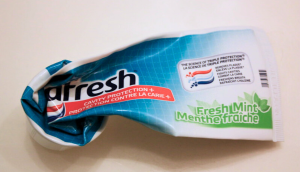
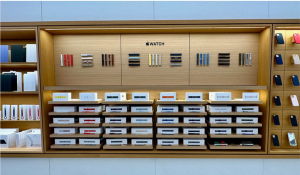
b.) Information Search
Marketplace information is all around us. Sometimes we are exposed to information without even searching for it, such as when we are scrolling on Instagram or TikTok. However, consumers also do search for information and find it in different ways and from different sources. There are three types of information sources:
- Commercial sources of information are sources that come from the company itself, such as advertisements, salespeople, the company’s website, or its social media accounts. It is important for companies to understand what information consumers are looking for and how to make that information easily accessible. Think about what type of information you usually look for when you visit a company’s website. You can evaluate a company’s information quality by how long it takes you to find that information and whether the information presented is helpful for your decision-making.
- Social sources of information usually come from other consumers who could be one’s family members, friends, or unrelated consumers online. These sources include social media influencers and experts who post reviews of different products or services. When you look at online reviews before making a decision, you are consulting a social source of information. Social sources are highly trusted by customers, and we use them for most of our decisions. Organizations can capitalize on social sources by having strategies to encourage consumers to spread positive word-of-mouth, such as incentivizing online reviews or investing in influencer marketing.
- Public sources of information include sources that are neither commercial nor social, such as government studies, academic journals, non-profit organization reports, publicly traded company reports, patent and trademark databases, product testing magazines, and media stories or news reports. These sources have a high level of reliability, but they require a high effort for consumers to obtain, so they are consulted mostly by consumers who are making high-involvement decisions and who have high expertise in the product or service category in hand. Companies can capitalize on the reliability of public sources by investing in public relations to generate positive publicity.
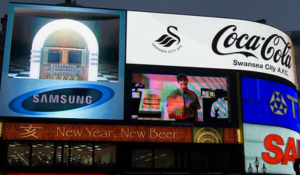
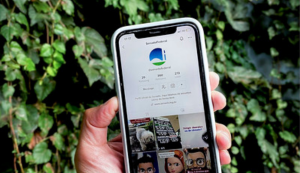

The information search stage of the decision-making process is often combined with the alternative evaluation stage discussed next.
c.) Evaluation of Alternatives
i.) Choice sets. When consumers evaluate alternatives in the marketplace, they do not evaluate all available alternatives. Most consumers are not even aware of every product or service that could fulfill their needs. Here is where choice sets become important. In this section, we cover the idea of choice sets using the funnel approach to decision-making. All the available solutions or brands in the marketplace constitute the universal set. The subset of brands that a consumer knows is called the awareness set.
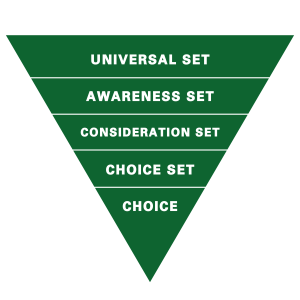 First, brands need to invest in awareness strategies to make sure that they are in the consumer’s awareness set. Let’s say that you are looking for an insulated tumbler. What brands are in your awareness set? Those are the brands that you can name from memory, for example, these might include Yeti, Stanley, Hydro Flask, and Contigo; but not Thermos, Klean Kanteen, or S’well. If you are in the target market of these latter brands, they need to work on increasing consumer awareness of their brands.
First, brands need to invest in awareness strategies to make sure that they are in the consumer’s awareness set. Let’s say that you are looking for an insulated tumbler. What brands are in your awareness set? Those are the brands that you can name from memory, for example, these might include Yeti, Stanley, Hydro Flask, and Contigo; but not Thermos, Klean Kanteen, or S’well. If you are in the target market of these latter brands, they need to work on increasing consumer awareness of their brands.
Next are the set of brands that are in your consideration set. These are the brands that you have a positive attitude towards or, in other words, the brands you find acceptable. For you, these might only include Yeti, Stanley, and Hydro Flask. The choice set is a set of brands your have decided to choose from after consideration. These would be the preferred brands, maybe Yeti and Stanley. The funnel approach posits that the consumer will choose one of these brands in their choice set. At this stage, marketing promotions are very effective in making one brand win over another. For example, if while you’re comparing the Yeti and Stanley tumblers, you receive an email from Yeti with a 15% discount, that promotion will likely steer you towards purchasing a Yeti over a Stanley tumbler.
ii.) Evaluative criteria. In order to be part of the consideration set, brands need to make sure that their products or services have attributes and benefits that match the needs of the consumers in their target market or the evaluative criteria of those consumers. Evaluative criteria are those attributes that the consumer is looking for in an offering or the criteria based on which consumers decide what makes it into their consideration and choice sets and what they end up purchasing. There are many types of attributes that consumers consider when evaluating alternatives. Some are tangible attributes, or the concrete mostly physical attributes that consumers can experience and evaluate, such as the design or materials of a product. To continue our example from the paragraph above, tangible attributes for a Yeti Tumbler might be that it’s double-wall vacuum insulated and made of stainless steel. Others are intangible attributes which consumers cannot directly perceive or measure, such as brand image or reputation, prestige, and customer service. Intangible attributes for Yeti could be ruggedness and sleekness.
Tangible attributes are usually linked to functional benefits pertaining to the functional or economic aspects of an alternative (e.g., saves money or time, has durability, is easy to use) and intangible attributes are usually associated with emotional benefits, or the feelings evoked by using or owning a product or service (e.g., joy, nostalgia, confidence).
Think about a product you often use such as your phone. What are some of its functional benefits (e.g., battery life, screen size, camera quality)? And what are some of its emotional benefits (e.g., making you feel connected with friends and family)?
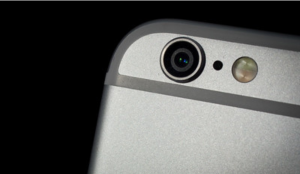

d.) Choice or Purchase
There are many ways consumers make choices. We distinguish between emotional and cognitive decision-making.
i.) Emotional decision-making is affect-based wherein consumers evaluate offerings based on the feelings evoked by each alternative. Emotional decision-making is usually at play when consumers make impulse purchases, low-involvement purchases, or experiential purchases which are focused on creating memories and evoking emotions during the lived experiences. Such purchases include concert or sports game tickets as well as the band t-shirt or N.F.L. player jersey that you might impulsively buy despite knowing how overpriced they are. When consumers engage in emotional decision-making, they sometimes make decisions based on the premise of “I will know it when I see it” rather than rationally comparing alternatives based on important evaluative criteria.
ii.) Cognitive decision-making is rational and attribute-based where consumers evaluate offerings based on the attributes that they consider important for their decision-making. This type of decision-making is more typical for high involvement purchases when consumers have enough information to compare alternatives and have the ability to evaluate that information. Some companies such as Amazon try to make this type of decision-making easier by providing a side-by-side comparison of different alternatives. For example, when looking for a laptop, consumers can benefit from comparing alternatives based on attributes such as price, customer ratings, battery life, screen quality, hard drive size, computer memory size, and processor speed.


e.) Post-Purchase Evaluation and Behaviors
Customer satisfaction is one of the most widely used measures of post-purchase evaluation by customers. The American Consumer Satisfaction Index (ACSI) provides overall satisfaction data for United States consumers and offers satisfaction benchmarks per industry for various industry sectors, such as healthcare, restaurants, retail, and travel.
i.) Customer satisfaction or dissatisfaction. After making a purchase, consumers experience the product or service and form a post-purchase evaluation of it. Consumers compare how the product or service performed to how they expected it to perform. This evaluation forms the basis of their customer satisfaction or dissatisfaction, which are a function of consumer expectations. The formula for customer satisfaction is actual performance minus expected performance of an offering. Based on the expectancy disconfirmation theory, consumers are satisfied when the actual performance exceeds expected performance. We term this positive disconfirmation. Conversely, consumers are dissatisfied when actual performance falls below expected performance. This is termed negative disconfirmation.
ii.) Customer loyalty. Customer loyalty is one of the most positive post-purchase behaviors that a company can expect from its consumers. Customer loyalty is a feeling of commitment that consumers have for the brand. This commitment goes beyond just repeat purchase because we can engage in repeat purchase without being loyal in terms of feeling committed. Think about the things you repeatedly purchase because of habit without feeling particularly committed to the brand. For a consumer, their list might include things like dental floss, ballpoint pens, or one-subject notebooks. Sometimes these are purchases where we have little choice, such as our internet service provider. Customer loyalty allows consumers to stay committed to a brand even in the face of competition or when the brand has to make negative changes such as increasing prices.
iii.) Negative post-purchase behaviors. When consumers are dissatisfied, they can engage in negative post-purchase behaviors such as negative word-of-mouth (e.g., writing a bad review or telling their friends not to consume a brand). Other forms of negative post-purchase behaviors include boycotting the brand, holding a grudge against a brand, complaining to the seller to try to obtain a refund or compensation, complaining to third parties such as the Better Business Bureau, or filing a lawsuit against the company. Although it does not seem intuitive, companies should encourage consumers to complain directly to them or to the seller so that they have a chance at fixing the problem through what we call recovery strategies. Think about a time when you were dissatisfied with a purchase. What post-purchase behaviors did you engage in? Did you give the company the chance to fix it? If so, how was your recovery experience? What could the company have done better to win you back as a customer or loyal customer?
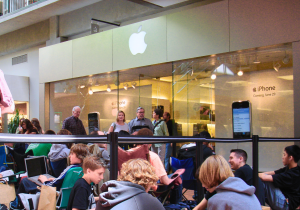
The marketer’s role does not end at the purchase or choice stage. In fact, marketers can play an important role during post-purchase evaluation by making sure their customers are satisfied through satisfaction surveys and friendly return or warranty policies. They can also encourage positive word-of-mouth from satisfied consumers using online review management systems. Finally, effective recovery strategies are crucial for marketers when a service or product failure occurs that causes customer dissatisfaction. Brands that succeed at matching their offerings to the right target market, fulfilling customer needs, and managing the customer post-purchase experience, are rewarded with high customer loyalty and high net promoter scores.
PERSONAL FACTORS THAT INFLUENCE CONSUMER BEHAVIOR
Consumer self-concept, personality, values, and lifestyles are drivers of how consumers spend their time and money. They play an important role in how marketers segment the marketplace, choose target markets, and position their products and services for those markets.
f.) Consumer Self-Concept
Consumers have thoughts and feelings about themselves that form their self-concept or self-image. This self-concept includes multiple types of self-images such as actual self-image and ideal self-image, where the difference between the actual and ideal self-images can motivate consumption behaviors that are aimed at self-improvement or social acceptance, for example. If our ideal self-image is to be stronger and healthier than our current actual self-image, we might engage in self-improvement consumptions that include a gym membership and healthier food options. It is important for brands to understand their customers’ self-concept because consumers often choose brand’s whose image matches their self-concept. The self-congruency theory explains this phenomenon. This theory posits that consumers are more likely to choose a brand whose image is perceived as congruent with one of their own self-images. Someone who perceives themselves as an eco-conscious consumer is more likely to buy a Toyota Prius than a Ram 1500 pickup truck. Marketers want to make sure that their brands have positive brand personality characteristics and a unique and positive brand image in the mind of their target consumers. Successful brands usually share one or more of the brand personality dimensions in the brand personality framework (see figure below). What are some products and brands you consume that you believe express your self-concept? What brand personality dimensions do these brands share? How do these dimensions match your own actual or ideal self-image?
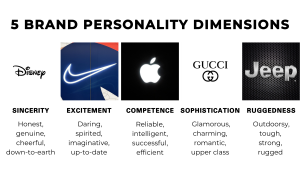
g.) Consumer Psychographics
Marketers’ ability to target different segments of consumers often requires psychographics, or the study of consumer personality and their values and lifestyles. Psychographic information is often combined with demographic information to obtain a full customer profile for a target segment.
i.) Personality is a person’s unique psychological makeup or combination of traits and characteristics that determine a person’s stable tendencies when they respond to the environment. Example personality traits used in marketing include innovativeness—the extent to which a consumer is open to new ideas and their tendency to adopt new products or services early on, value consciousness—the extent to which a consumer tends to maximize what they receive from a transaction compared to what they pay, and materialism—the extent to which material goods have importance in a consumer’s life. Personality traits constitute one way to identify segments of consumers in the marketplace.
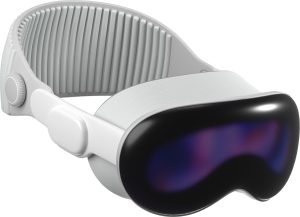
For example, in 2024, Apple targeted consumers who are high on innovativeness when marketing its Vision Pro mixed-reality headset. The slogans and marketing materials for the Vision Pro make many references to its newness (e.g., “You have never seen everything like this before”) or to its futuristic new era characteristics (e.g., “Welcome to the era of spatial computing”).
ii.) The lifestyle of a consumer can be defined as how that consumer spends their time and money. Lifestyle is driven by a consumer personality as well as by their value systems. To understand consumers’ lifestyles, one must know about their activities (e.g., work, hobbies, club memberships, vacation behaviors, etc.), their interests (e.g., home, family, community, fashion, food, etc.), and opinions (e.g., opinions about culture, politics, economics, education, etc.). We refer to these as the AIOs.
Companies can use surveys to measure consumer psychographics and demographics to help them understand their target market when they develop their products and services and make decisions about how to position these offerings and how to communicate in a way that effectively connects them to their customers. In order to do so, companies can use established syndicated surveys conducted by a third-party research provider, such as Strategic Business Insights, which hosts one of the most well-known psychographic surveys, the Values and Lifestyles Survey or VALS. The VALS consists of 35 questions measuring values, lifestyles, personality traits, and demographics and helps segment the marketplace into eight market segments (e.g., achievers who follow traditional life paths, strivers who live in the moment, and experiencers who are trend adopters that go against the mainstream). Using psychographic information, companies can build consumer personas for their ideal target customers that help guide their product design and brand positioning decision across the company.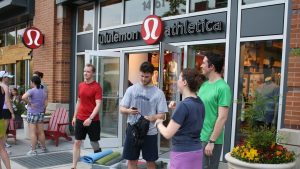
For example, the brand lululemon was designed with the persona of Ocean in mind. Ocean is a 32-year old single woman who makes $100k a year and who needs athleisure wear for her daily activities which include working out about 90 minutes each day (Lutz).
THE IMPACT OF PSYCHOLOGICAL FACTORS ON CONSUMER BEHAVIOR
Persuading consumers to try or adopt a brand, product, or service requires an understanding of how they perceive the world around them, what motivates them to behave the way they do, and how their attitudes are formed and changed.
h.) Consumer Perception
Consumer perception refers to the process by which individuals select, organize, and interpret information from the environment to create a meaningful picture of the world.
i.) The consumer perception process starts with exposure to stimuli such as a company’s website, an advertisement, a user of the product, or other sources of information. Exposure is followed by attention if the consumer is interested in the product or service, or if the information was presented in a way that enhances consumer attention. Finally, consumers evaluate and interpret the information or stimuli they are exposed to in the last stage of the process, comprehension.
ii.) Perceptual biases. These stages can be influenced by consumer perceptual biases such as selective perception. Consumers can have selective perception by only exposing themselves to certain types of information, i.e., having selective exposure. For example, a person with left-wing politics might only expose themselves to news outlets that are left-leaning. Consumers can also have selective attention (e.g., consumers may notice ads for products they’re interested in such as vacation ads when they are planning a Spring Break trip). Finally, selective distortion is when selective perception occurs at the comprehension stage and consumers interpret stimuli and information in a way that aligns with their existing beliefs (e.g., an Apple iPhone user might distort information about the superiority of a Samsung Galaxy phone over their iPhone for certain attributes).

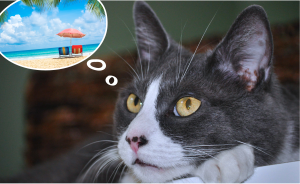
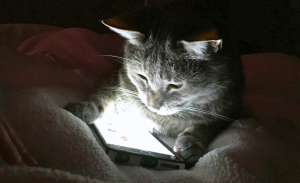
Understanding consumer perception and consumers’ perceptual biases can help marketers design effective marketing strategies and product offerings. For example, consumers tend to extrapolate from first impressions or evaluate the overall quality of a product based on one piece of information, a tendency called the halo effect. Knowing that consumers have this perceptual bias, a high-end service firm could invest in creating an attractive and upscale front-desk lobby waiting area to make a positive first impression on customers.
i.) Consumer Motivation
Consumer motivation is what drives us to do everything that we do. This usually starts with need activation, when a consumer is driven to achieve an end goal by fulfilling a need.
i.) Regulatory focus theory posits that we are driven to achieve positive goals by having a promotion focus for self-improvement (e.g., a consumer who runs to have better cardiovascular health), and we are driven to achieve negative goals by a prevention focus to avoid things getting worse (e.g., we brush our teeth to prevent decay). Sometimes different consumers can perform the same behavior but be driven by a different focus. For example, consumers choosing to get a college degree could be driven by the promotion focus desire to get a high paying job or by the prevention focus desire to avoid upsetting their family members.
ii.) Maslow’s hierarchy of needs. In 1946, Abraham Maslow advanced the human theory of motivation and a hierarchy of needs that is still used today to understand the needs that motivate consumer behaviors. Maslow’s hierarchy of needs is based on the idea that consumers seek to fulfill their most basic physiological needs first (e.g., water and food). Consumers then seek emotional needs such as the needs for safety (e.g., shelter, alarm systems, life insurance) and for love and belonging (e.g., phone with the ability to video chat with long-distance friends or family members, club membership, brands with communities). Once those are fulfilled, consumers can go after higher-level psychological needs for esteem (e.g., luxury car, business credit card, country club membership) or self-actualization (e.g., hobbies and passions, travel, education).
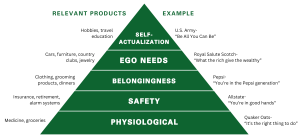
Brands cater to these different needs in a way that is made clear by their product or service benefits and even their brand communication through slogans. For example, Allstate’s slogan “You’re in good hands” obviously targets consumers with the needs for safety while Rolex’s slogan “A crown for every achievement” speaks to consumers with esteem needs.


j.) Consumer Attitudes
Consumer attitudes refer to the enduring and learned predispositions or evaluations that individuals hold towards products, services, brands, or ideas.
i.) Attitude components and characteristics. Consumer attitudes consist of a cognitive component called belief, an affective emotional component termed affect, and a behavioral component such as intention or action. Beliefs are consumer perceptions of the attributes, features, or characteristics an offering has (e.g., Tesla cars are luxurious; or Tesla cars are environmentally sustainable). Affect is related to the emotions consumers associate with using or owning a brand (e.g., driving a Tesla car would be exciting or enjoyable). Behavior is about a consumer’s intentions or actions towards a brand (e.g., when I am ready to buy my next car, I will buy a Tesla; or I recommend buying a Tesla car to my friends and family). Consumer attitudes are relatively stable and enduring, but they are also learned and can be influenced by various factors, including marketing efforts.
ii.) Persuasion. The act of changing consumer attitudes, can be achieved through communication by, for example, carefully selecting the source of the message that best matches the brand image and elicits a positive response from the target market (e.g., using celebrity endorsers or social media influencers with a positive image among target consumers), or by using emotional appeals, such as humor appeals or fear appeals. Think about successful celebrity endorsements of brands, like Jeff Goldblum for Apartments.com, Kevin Hart for Draftkings, or Steph Curry for Subway. What makes these endorsements work? What makes consumers evaluate the source of a message positively? Some important source characteristics marketers need to consider when selecting a sources such as a celebrity endorser include: 1) source credibility, which encompasses both expertise—the knowledge, experience, or skills a source is perceived to have in that product category (e.g., Tiger Woods is perceived to have high expertise in golf), and trustworthiness—the extent to which customers perceive the source to be truthful about the message (e.g., a source that is perceived to have ulterior motives such as recommending a brand they don’t believe in just for financial benefits is low on trustworthiness); 2) source attractiveness not just in terms of appearance but in terms of personality, status, and similarity to the consumer; 3) source likeability or how likable a source is among the target consumers; and 4) source meaningfulness or the fit between the source’s personality and the brand’s personality. All these factors impact the persuasiveness of a source.
Emotional appeals are another way to grab consumer attention and change their attitudes towards a brand. If you think about the Super Bowl commercials from the last Super Bowl you watched, how many of them used emotional appeals that were engaging and attention grabbing? What types of appeals were they? You likely saw a mixture of humor, fear, sex, and heartwarming appeals.
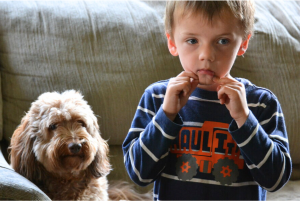
Humor appeals are frequently used because of their effectiveness in grabbing attention, their power to enhance consumers’ mood, and the effectiveness of linking a brand to a positive emotional experience such as joy or laughter. Fear appeals are most effective when used at moderate levels and when the company can convince consumers that there is a threat, that the threat can happen to them, and that it has a product or service that can alleviate that threat. For example, security systems companies often use fear appeals by showing that a break-in can happen to their customers and that their alarm systems can help by contacting the authorities and preventing the theft of property and harm to its residents. The key idea is that these appeals aim to stir up warm and affectionate feelings in the audience by tapping into concepts like love, family, nostalgia, compassion, or touching human experiences. When executed well, they can forge emotional connections and make persuasive messages more impactful and memorable (Claude.ai).
SOCIAL INFLUENCES ON CONSUMER BEHAVIOR
Consumers’ decisions and behaviors are almost always influenced by the people surrounding them physically and virtually. Marketers can take advantage of these influences and use this knowledge to help the adoption of their offerings.
a.) Reference Groups
Reference groups are people whose perspective a consumer takes into consideration when forming attitudes and engaging in behaviors, simply put, this is anyone who is relevant to the consumer and can influence their opinions and behaviors.
i.) Types of reference groups. Reference groups can be primary or secondary, with primary groups having more direct and frequent contact with the consumer (e.g., a group of close friends or members of a sorority in which the consumer is highly engaged vs. a group of classmates or a group of parents of kids on your child’s soccer team). Reference groups can also be formal or informal. Formal reference groups require a formal membership process and have stricter norms or codes of conduct (e.g., a student organization, a sports team), while informal groups such as friends have no formal processes or codified norms. Reference groups can also be aspirational, or groups the consumer would like to become part of (e.g., group of local business owners in the consumer’s region), or dissociative, which are groups that the consumer would like to avoid being part of (e.g., racist groups).
ii.) Social power of reference groups. Reference groups can have different types of social power that lead consumers to be influenced by them in their opinions and behaviors. Referent power is shared by people who have power because consumers look up to them (e.g., successful business people or celebrities, like Elon Musk or Kim Kardashian). Reward power is the power to reward consumers who conform to the norms of the group (e.g. college sports teams rewarding their members with scholarships). Coercive power, which is often shared by the same groups who have reward power, is the power to punish or sanction consumers (e.g., friends who can exert peer pressure on a consumer). Expert power can be exerted by people who are perceived as having knowledge and skills in a specific area (e.g., doctors recommending a pharmaceutical product). Legitimate power stems from legal or contractual authority (e.g., the IRS or a consumer’s landlord).

a.) Conformity and Normative Influence
A social norm is a rule of behavior for meeting the expectations of a reference group. Conformity is the extent to which members of a group adhere to the social norms established by that group. Conformity can be influenced by group characteristics such as group size, expertise, status, and unanimity—with all of these being positively associated with conformity. It can also be driven by consumer characteristics such as how susceptible they are to interpersonal influence or how connected they perceive themselves to be with the group. Another driver of conformity is a consumer’s fear of consequences if they do not adhere to group norms. A reference group’s normative influence on consumers is the influence the group has because of consumers’ desire to avoid punishment or to receive a reward from the group. In 1951, Arthur Ash conducted experiments that showed the power of normative influence on conformity. Marketers can use the power of normative influence to persuade consumers to engage in specific behaviors.
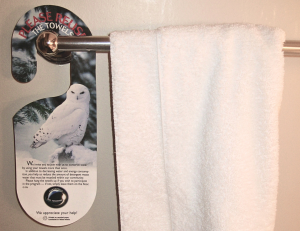
For example, hotels that would like their consumers to reuse their towels in order to conserve water can use a social norm messaging in addition to an environmental messaging (e.g., “Many of our guests expressed to us their approval of conserving energy, and nearly 75% of hotel guests choose to reuse their towels”). This type of messaging has been shown to be effective in increasing towel reuse (“How Social Norms Conserved Energy”).
REFERENCES
Babin and Harris. CB. Cengage Learning. 2021.
Lindquist and Sirgy. Shopper, Buyer, and Consumer Behavior. Cengage Learning. 2008.
Shiffman and Kanuk. Consumer Behavior. Pearson Education. 2009.
Solomon, Michael. Consumer Behavior: Buying, Having, and Being. Pearson Education. 2016.
Solomon, Michael. Consumer Behavior. 8th edition. Prentice Hall. 2008.
Lutz, Ashley. “Lululemon calls its ideal customers ‘Ocean’ and ‘Duke’ – here’s everything we know about them.” Business Insider. https://www.businessinsider.com/lululemon-idea-customers-ocean-and-duke-2015-2. February 2, 2015.
“How social norms conserved energy by increasing hotel towel reuse rates by 36%.” The Decision Lab. https://thedecisionlab.com/intervention/how-social-norms-conserved-energy-by-increasing-hotel-towel-reuse-rates-by-36
Media Attributions
- Header by Z. Farley
- Dealership by Alexander Nie, licensed under CC BY-SA 2.0
- Fries by Pexels via Pixabay, licensed under CC0
- Empty by Jennifer Bolt, licensed under CC BY 2.0
- Display by F Delventhal, licensed under CC BY 2.0
- Billboards by Cristiano Betta, licensed under CC BY 2.0
- Senado Federal no TikTok by Agência Senado, licensed under CC BY 2.0
- Hometown Heroes Awards by MTA, , licensed under CC BY 2.0
- Fig. by Z. Farley
- iPhone 6 by Paul Hudson, licensed under CC BY 2.0
- Selfie by Jimmy Baikovicius, licensed under CC BY-SA 2.0
- Festival! by Martin Fisch, licensed under CC BY 2.0
- Desktop Online Shopping by DealDrop.Com, licensed under CC BY 2.0
- Waiting in line for iPhone by Quintin D, licensed under CC BY 2.0
- Chart by Z. Farley
- 3D illustration of Apple vision Pro headset by Joy Siloko, licensed under CC BY-SA 2.0
- RunClub.Lululemon by Elvert Barnes, licensed under CC BY-SA 2.0
- Coronavirus news by frankieleon, licensed under CC BY 2.0
- Day Dream by Allie Couture, licensed under CC BY-SA 2.0
- Cat addicted to iPhone games by Todd McCann, licensed under CC BY 2.0
- Allstate by Mike Mozart, licensed under CC BY 2.0
- Rolex by Falcon Photography, licensed under CC BY-SA 2.0
- Nathaniel by Tony Alter, licensed under CC BY 2.0
- Photo 1. KKW by Eva Rinaldi, licensed under CC BY-SA 2.0. Photo 2. Graduation by Alan Light, licensed under CC BY 2.0. Photo 3. Middle school lunch room by woodleywonderworks, licensed under CC BY 2.0. Photo 4. Happy Doctor by Lisa Brewster, licensed under CC BY-SA 2.0. Photo 5. Taxes by John Morgan, licensed under CC BY 2.0.
- Please Think of the Owls by Infrogmation of New Orleans, licensed under CC BY 2.0
Pre-purchase, purchase, post-purchase
The first stage of the consumer decision-making process. Steps include need recognition, information search, and evaluation of alternatives
The second stage of the consumer decision-making process. Includes the "choice" step
The third stage of the consumer decision-making process. Steps include post-purchase evaluations and behaviors
A decision we perceive as important and risky
Triggered when the difference between the consumer’s actual (current) state and their idea state is large
A trigger of need recognition. Is a decline in one’s actual or current state
A trigger of need recognition. Is an increase in one’s ideal state
Information sources that come from the company itself, such as advertisements, salespeople, the company’s website, or its social media accounts
Information sources from other consumers like family members, friends, or unrelated consumers online
Information sources that are neither commercial or social, such as government studies, academic journals, non-profit organization reports, publicly traded company reports, patent and trademark databases, product testing magazines, and media stories or news reports
All the available solutions or brands in the marketplace
The subset of brands that a consumer knows
Brands the consumer has a positive attitude towards or, in other words, the brands the consumer finds acceptable
Brands that the consumer has decided to choose from after consideration
Posits that consumers will choose one of the brands in the their choice set
Attributes that the consumer is looking for in an offering or the criteria based on which consumers decide what makes it into their consideration and choice sets and what they end up purchasing
The concrete mostly physical attributes that consumers can experience and evaluate, such as the design materials of a product
Attributes which consumers can’t directly perceive or measure, such as brand image or reputation, prestige, and customer service
Pertain to the functional or economic benefits of an alternative. Usually linked with tangible attributes
The feelings evoked by using or owning a product or service. Usually associated with intangible attributes
Consumers evaluate offerings based on the feelings evoked by each alternative
Consumers evaluate alternatives based on the attributes that they consider important for their decision-making
Actual performance minus expected performance for an offering
Consumers are satisfied when actual performance exceeds expected performance
Consumers are dissatisfied when actual performance falls below expected performance
A feeling of commitment that consumers have for the brand
The thoughts and feelings consumers have about themselves
Posits that consumers are more likely to choose a brand whose image is perceived as congruent with one of their own self-images
The study of consumer personality and their values and lifestyles
A person’s unique psychological makeup or combination of traits and characteristics that determine a person’s stable tendencies when they respond to the environment
The extent to which a consumer is open to new ideas and their tendency to adopt new products or services early on
The extent to which a consumer tends to maximize what they receive from a transaction compared to what they pay
The extent to which material goods have importance in a consumer’s life
How a consumer spends their time and money
Activities, interests, and opinions
Also known as VALS. Consists of 35 questions measuring values, lifestyles, personality traits, and demographics and helps segment the marketplace into eight market segments
The process by which individuals select, organize, and interpret information from the environment to create a meaningful picture of the world
Exposure, attention, and then comprehension
Can affect the consumer perception process. Examples include selective perception, selective attention, and selective distortion
A perceptual bias consumers can have when only exposing themselves to certain types of information
A perceptual bias consumers can have when, for example, they notice ads for products they're interested in such as vacation ads when they are planning a Spring Break trip
When selective perception occurs at the comprehension stage and consumers interpret stimuli and information in a way that aligns with their existing beliefs
A tendency where consumers tend to extrapolate from first impressions or evaluate the overall quality of a product based on one piece of information
When a consumer is driven to achieve an end goal by fulfilling a need
Posits that we are driven to achieve positive goals by having a promotion focus for self-improvement, and we are driven to achieve negative goals by a prevention focus to avoid things getting worse
Based on the idea that consumers seek to fulfill their most basic physiological needs first. Consumers then seek emotional needs such as the needs for safety and for love and belonging. Once those are fulfilled, consumers can go after higher-level psychological needs for esteem or self-actualization
The enduring and learned predispositions or evaluations that individuals hold towards products, services, brands, or ideas
Consumer perceptions of the attributes, features, or characteristics an offering has. Is a cognitive component of consumer attitudes
Related to the emotions consumers associate with using or owning a brand. Is an affective emotional component of consumer attitudes
A consumer's intentions or actions towards a brand. Is a behavioral component of consumer attitudes
The act of changing consumer attitudes
Encompasses both expertise and trustworthiness
Consists not only of appearance, but also personality, status, and similarity to the consumer
How likeable a source is among the target consumers
The fit between the source’s personality and the brand’s personality
A way to grab consumer attention and change their attitudes toward a brand
Frequently used because of their effectiveness in grabbing attention, their power to enhance consumers’ moods, and the effectiveness of linking a brand to a positive emotional experience such as joy or laughter
Most effective when used at moderate levels and when the company can convince consumers that there is a threat, that the threat can happen to them, and that it has a product or service that can alleviate that threat.
People whose perspective a consumer takes into consideration when forming attitudes and engaging in behaviors
A type of reference group that has direct and frequent contact with the consumer
A type of reference group that requires a formal membership process and has stricter norms or codes of conduct
A type of reference group that has less strict norms or codes of conduct
Groups that consumers would like to become part of
Groups that the consumer would like to avoid being part of
Shared by people who have power because consumers look up to them
The power to reward consumers who conform to the norms of the group
The power to punish or sanction consumers. Often shared by the same groups who have reward power
People who are perceived as having knowledge and skills in a specific area
Stems from legal or contractual authority
A rule of behavior for meeting the expectations of a reference group
The extent to which members of a group adhere to the social norms established by that group
The influence the group has because of consumers’ desire to avoid punishment or to receive a reward from the group
